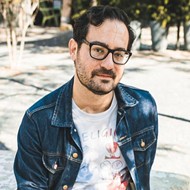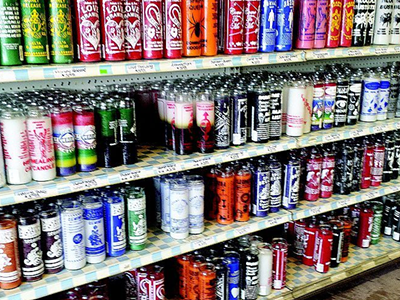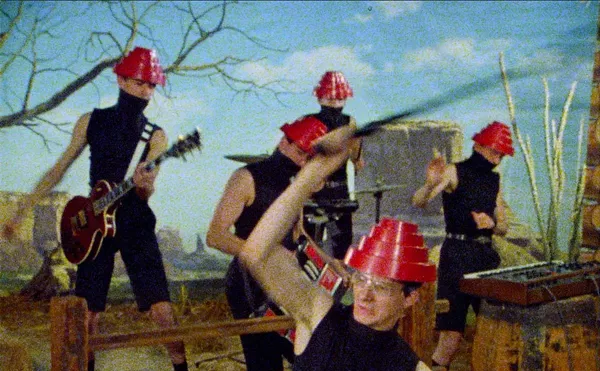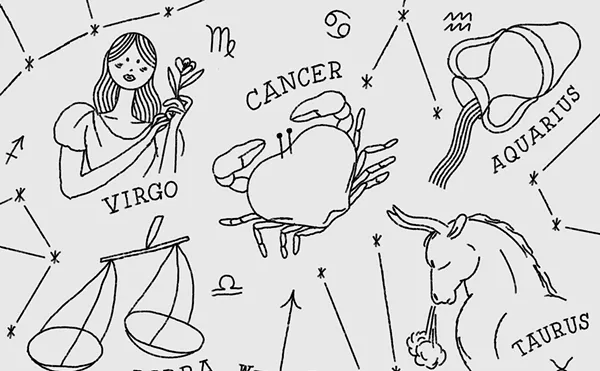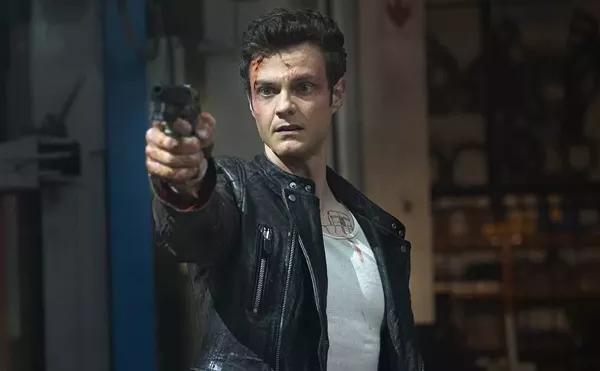While walking to Mildred Head's residence, we notice two young white women on ladders, making repairs to the side of her house. After understandably hassling us for taking a photo of them without asking permission, we tell them Guyton sent us here, and they come down to talk to us.
They introduce themselves as Trista Dymond and Jessica Kezlarian, and introduce themselves as Heidelberg project site manager and site designer, respectively.
We ask what their roles were before they got busy with fire cleanup. Dymond admits there's been a shift in her duties in the past year. "It's just Dumpster after Dumpster of ash," she says. "So many volunteers, hundreds of volunteers come through and that's part of my job — the managing of volunteers. Jess will take a group and I'll take a group and we'll go."
They explain that they're currently scraping off the paint on the Head's house that has bubbled and peeled in the fire. Next, they'll paint a new coat on it, and then clean out ash from the basement from the "Clock House" next.
"It's getting to a point where we've kind of caught up," Dymond says. "Knock on wood."
Dymond explains that they partner with groups Young Detroit Builders and Rebuilding Together Detroit, groups that do volunteer work with young builders who are learning a vocation. She says the groups provide labor, or sometimes a donation or otherwise a good deal.
Kezlarian apologizes for hassling us about the camera. "I only jumped on you with the camera thing because I can't tell you how many times people take pictures without even asking," she says. "My apologies."
"They don't think of it as a neighborhood," Dymond says of the tourists. "They're just like, 'Wow! Bright colors!'"
And that is the crux of the conundrum posed by the Heidelberg Project. Is it an art installation, or a neighborhood? Can it be both?
According to Dymond, up until the recent rash of arsons, there was no serious crime reported on Heidelberg Street since Tyree started transforming it. "Other than petty theft and things like that, there's been a severe decrease in crime (since the Heidelberg Project started)," she says. "And that's what really started all this — art as a catalyst for change, art as medicine. Something positive is coming through this, and people are drawn to it. It's something that we can't really fully describe."
It's hard to empirically quantify the effect the Heidelberg Project has. At one point, it was found that Heidelberg drew more than 275,000 visitors annually — making it the third-most visited tourist destination in Detroit. In 2012, the Heidelberg Project made the front page of Crain's Detroit Business when it was determined to bring $3.2 million into the region on a budget of $410,000.
But Kezlarian says the recent arsons are noticeably shaking up the local community.
"Losing the art sucks in a lot of ways and was a godsend in others," she says. "But it's endangering our neighborhood and our neighbors and the people who were here before us. Our neighbors here who have lived longer than the project has, they're scared, and rightly so. That's the hardest thing. We can't promise their safety as much as we wish that we could. That's the hardest part."
Kezlarian wonders what the neighborhood would be like without Guyton. "You can't forget what we've done over the years and what would be here in our stead if we hadn't at least tried our best."
Dymond agrees. "There's generations of kids that love this place, and it's a safe place to come," she says. "They can play on the playground. Tyree works with them and gives them a little broom."
"We get to teach them how to use a claw hammer," Kezlarian says, her eyes lighting up. "And a drill. The older they are, the more responsibilities."
"In any case," Dymond says, "it's something very positive. And it's been proven time and again."
Back in the "office," Guyton pulls another quote out of his folder, this time from Pablo Picasso: "'Painting is just another way of keeping a diary,'" Guyton recites. "Here's a great chance for me to share with the world parts of my diary."
Guyton takes us to the side of the polka-dotted house, where his latest art project is in progress. It's a series of car hoods, similar to the ones that line the fences of the neighborhood. These hoods are warped, rust brown in color, but with the same colorful, grinning faces painted on top — though these seem to be even brighter than the others. Yet despite the smiles, there's something almost confrontational about them.
"Every one of those car hoods had faces painted over them," he says. "The fire created what you see now — the roughness. It removed the faces that were painted on those. I'm taking some of those car hoods, and I've started to paint on top of that surface again."
The painted car hoods were put in storage in the "War Room" following the 1999 demolition.
"The first thing we wanted to do was to clean up," he says. "Get them outside and out of the house. I told my guys to just stack them. All of a sudden, wow! Then I knew.
"The fire took it to a new level and provided a new canvas."
Guyton will exhibit the faces at an art show at the Inner State Gallery. In a career that has seen Guyton repurpose every manner of objects as part of the Heidelberg Project, he's now repurposing his own art. It's the same thing Guyton's always done — back when his block was blighted in '80s, back when the city bulldozed the first houses back in 1991 and in 1999. Making lemonade out of nothing.
"I don't want to just talk," he says. "I want to do something. When you come over here and people invite you to panel discussions at the university as part of a roundtable to talk about the city ... I'd rather be busy fixing it."
Some people fight fire with fire. Tyree Guyton fights fire with smiles.
"I'm gonna give you a prescription today," he says. "I'm gonna tell you to keep standing. Keep fighting. Keep believing. It's already over, and you've already won. You just have to keep fighting. That's when you know you're right, when you've got people fighting you. You need opposition. It lets you know that you're trying to do something good."
Where the "House of Soul" once stood, Guyton's volunteers have erected a frame for a new house. In the middle of the frame is a crucifix with the words "Soul Never Dies" painted on it, with vinyl records like the ones that were once nailed to the side of the house dangling on strings in the breeze. The "House of Soul" will be rebuilt. Other future plans include a 30-year retrospective exhibit in the works for the University of Michigan, and an art show in Paris.
"You can't stop it," Guyton says. "You can't get discouraged. If you can make it here, you can make it anywhere in the world. Detroit has a way of giving you adversity, and it's either gonna make you or it's gonna break you. And I choose to move on. I choose to learn from this. We've had 10 fires, and now I see something greater. I won't stop.
"Let's say I made up my mind and decided I wasn't gonna do anything, and just let all that debris stay there. What would that say about us? What would it say about our city? I want to keep hope alive by doing what I'm doing. So I didn't wait on the city to come in here. This team of people, we got together and we strategized and came up with a plan to clean it up. This, to us, is a new canvas."
A man walks by carrying a handful of colorfully painted sticks. Guyton interrupts his train of thought and beckons the man over.
"Hey! Check this out," he says. "That's the Stick Man."
We ask the Stick Man what his sticks are for.
He looks at us and says, matter-of-factly, "They keep away the boogeyman."
Tyree Guyton: Spirit has an opening reception from 7 p.m. to 10 p.m. on Friday, Oct. 17 at Inner State Gallery; 1410 Gratiot Ave., Detroit; 313-744-6505; innerstategallery.com. Runs through Nov. 15.


